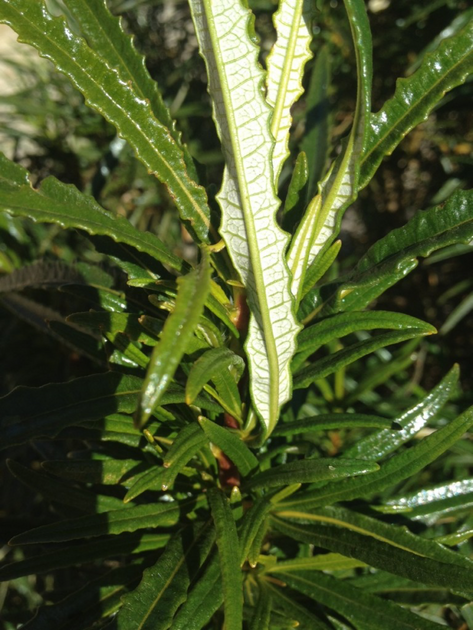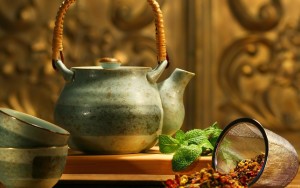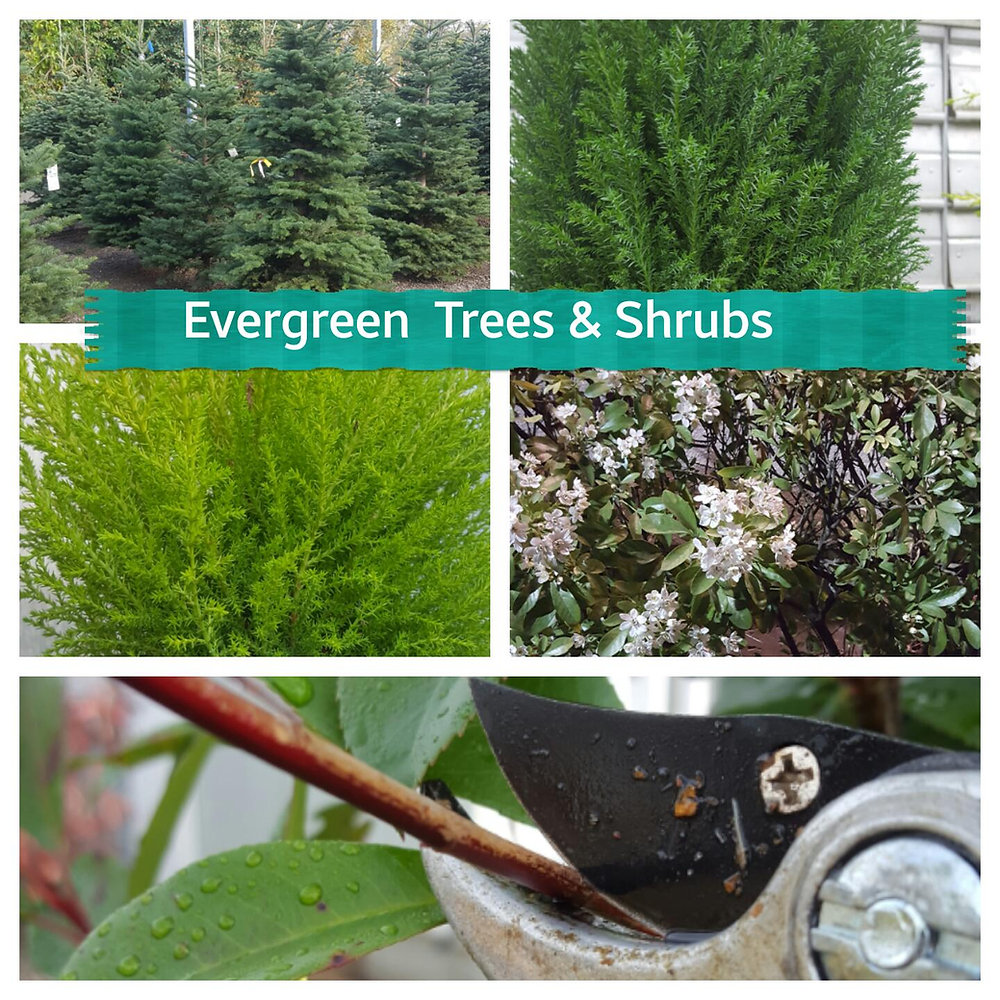Eriodictyon angustifolium – Yerba Santa: notice the “wooly-network of veins”
Other Names: Mountain Balm, Bear’s Weed, Consumptive Weed, Gum Bush, Holy Herb, Sacred Herb, Wild Balsam
Origin: Native to California, Oregon, Nevada, Utah, Arizona, and Baja California.
Energetics: Warm & Dry. Sweet, pungent, slightly bitter. Vital Stimulant, Tonic Astringent, Relaxant.
Properties: Decongestant, expectorant, mucolytic, anticatarrhal, bronchial dilator, carminative, antiseptic, antispasmodic, antioxidant, astringent, digestive, disinfectant, stimulant.
Uses: Internally: Cough, cold, flu, chest congestion, urinary tract infection, gas, bloating, asthma, bronchitis, catarrh, cystitis, leucorrhea, vaginitis, diarrhea, dysentery, fever, hay fever, sinusitis, hemorrhoids, pharyngitis, laryngitis, pneumonia, pleurisy, rheumatism, sinus congestion, sore throat, smoker’s cough, tuberculosis, syphilis. Externally: Broken bones, bruises, sprains, strains, fever, insect bites, stings, poison oak and ivy rash, eczema, sores, rheumatism, partial paralysis.
Sacred Herb
“Eriodictyon” comes from the appearance, at least on the underside, of each species’ leaf pattern and appearance; Erio – “wooly” and dictyon – “network of veins.” E. angustifolium is the only Yerba Santa found in Arizona, and is rarely found in California. There are at least 7 other species found in California, two of them threatened. They range from sticky sweet (E. californicum) to soft and wooly (E. crassifolium) and somewhere in between (E. trichocalyx). Our E. angustifolium is very similar in appearance and characteristics to E. californicum which was the official drug plant of the previous century (USP in 1894-1956 and the National Formulary in 1947). It was perhaps E. californicum which first became known by the Spainards as Yerba Santa in the hills of northern California. For the native population of that terrain turned to it time and time again to treat a range of maladies not least of which were the raspy cough and other wet lung symptoms which arrived at the onset of each cold, damp, cloudy season. To see this simple plant treat so many illnesses, so effectively, the holy men of the Old World thought it must have been sent by God for its people . . . thus, it was named YERBA SANTA!
Eriodictyon crassifolium – Yerba Santa
Expansive Breathing
Yerba Santa does one thing especially well. It opens up the lungs and removes and dissolves accumulated phlegm. This effect is felt up in the sinuses as well, thus its use in hay fever and sinusitis. Whenever the lungs feel encumbered by excessive moisture Yerba Santa is indicated. It stimulates and irritates the mucous membranes of the pleural lining to loosen up and “sweat out” the phlegm accumulated. It is one of my go-to remedies for the upcoming season. I have come to notice a certain phenomenon in our area. In just such years as this one, especially, the accumulated moisture of the summer season, if not expressed properly from the body can lead to solidified concretions in the lungs once the cold season arrives. Various factors will influence this including diet, weather, environment, personal constitution, etc. Along with Cottonwood leaf buds and Gumweed flowers, Yerba Santa works well to, as I say, “sweat out” this accumulated phlegm. It first needs to be liquified before it can be excreted. Irritating the lungs without first liquifying can prove ineffective for clearing the mucous. Yerba Santa does both. It is both mucolytic and expectorant. Any congestion from the upper to lower respiratory tract is improved with Yerba Santa. Here the tea works best, particularly of the more wooly species (E. crassifolium is a good example) as they are more drying. The resinous species make the best tincture, but were also traditionally used as a quid or chewed to extract the plant juices. Not only was this done for medicine, it was a favorite “past-time” to create a sort of chewing gum from the leaves rolled into a ball and dried in the sun. At first, somewhat bitter, a sublime sweetness follows. The resins just don’t convert as well into a tea. Another way to extract the medicine of Yerba Santa is via an oxymel preparation. As a vinegar decoction preserved with honey, by nature, it is directed towards the lungs with an expectorant and drying effect. Yerba Santa only serves to improve on this aspect. Another traditional method is to inhale the vapors emitted by the simmering herb.
E. angustifolium Dried Inflorescence
Other Uses
Our resinous Yerba Santa is particularly suited for alleviating urinary tract infections. Chronic cystitis responds well to regular use of Yerba Santa tincture, 20-40 drops, 3x/day. Used as a douche or pessary, it has been used to alleviate leucorrhea and vaginitis. As a decongestant it affects the respiratory system as well as the auditory. Middle ear congestion can be drained and cleared up with the use of our wooly species, in particular. Not to say that the other Yerba Santas wouldn’t be of service, but ideally speaking the wooly species are more drying and therefore better decongestants. Drink 1/2 cup of the infusion (1 ounce of herb per quart of water), 2-4 times per day. You can combine it here with Horehound, Brittlebush, or Yerba Manso. A bit of the tea in a neti pot may also be of use. Traditionally, the herb was used to treat bruises, breaks, and sprains as a poultice. Plants were often heated on hot coals or quickly boiled to be used in this way. I have not utilized Yerba Santa for this purpose, but I would imagine that its warming energy would help disperse the blood stagnation and coagulation associated with acute trauma. I have noticed that internal use of the tincture made me more aware of physical tension as it began to “un-wind” my muscle tension somewhat, so there is a musculoskeletal effect from internal use as well.
It was traditionally used as a wash for poison oak/ivy rashes as well as eczema. I have not had the opportunity to use it for such cases. As was once the custom, Yerba Santa was smoked to allay bronchial spasms often combined with Mullein and Coltsfoot.
Some time ago a woman came to my table at the farmer’s market and mentioned how they used Yerba Santa tea for her father once they discovered he had Alzheimer’s disease. This was the first mention of this that I had heard. She said that it had helped control his senility for a time. Author Matthew Wood discusses Yerba Santa as ‘guarding the sanctity of psychic space.’ He writes that it applies itself to the internal body linings such as the pleural cavity, meninges of the brain, and the synovial fluid linings of the joints. Furthermore, the illnesses treated by Yerba Santa are deteriorative in nature. His thoughts seem to correlate with this particular usage. Very interesting.
Anchor
A special property of Yerba Santa which I’ve discovered within its presence in the wild has to do with holding firm. You may place this in the category of flower essence therapy, or simply its nature as a plant being. I feel it holding truth with integrity, anchored within this sense of rootedness come what may. As the world spins around us at ever increasing speed with vast arrays of information, disinformation, tragedy, opportunities, changes, emotional swings, loss and gain, this remedy provides a sense of immovability – a center which does not move, remains constant. Perhaps this is a purist notion, but it is what I feel from this plant on a subtle level. It is the epitome of tai chi. A sense of neutrality, a piece of drift wood flowing with the current yet does not sink. Turning to face each occasion fresh from moment to moment. This strength, this characteristic is present within the spirit of this plant. How to harness it? Perhaps it is not harness-able. Perhaps it is there to be with in time and experience as the seasons turn.
Eriodictyon angustifolium – Yerba Santa
Collecting & Preparation
The plant is gathered whenever fresh, green, and vibrant. In southern California, this is often in the early spring. In northern California, late spring to mid-summer, or before the herb dries out. In Arizona, the plant can potentially be harvested from April to November. It depends on whether there has been proper moisture or not. The plant can look brown and withered in early July, but be vibrant in early November. It all depends – get to know your plants. Prune the fresh, flexible new growth at the end of the branch. Gather no more than 10% of the branches from any one plant. Dry the wooly varieties loosely in paper bags. The resinous species must not be clumped together lest they develop mold from the trapped moisture – laid out on a screen or cloth in the shade and checked periodically to turn and mix. Then strip the leaves and use as desired. The stem can be discarded or used with less effect.
Yerba Santa can be used in the following ways: Decoction, Tincture, Fresh or Dry, Syrup, Oxymel, Wash, Poultice, Steam Inhalation, Douche, Pessary, Chew, Smoke, Smudge.
References
Bean, Lowell John & Katherine Siva Saubel. 1972. Temalpakh: Cahuilla Indian knowledge and usage of plants.
Ganora, Lisa. Herbal Constituents: Foundations of Phytochemistry.
Holmes, Peter. 2007. The Energetics of Western Herbs, Vol.1, Fourth Ed.
Kane, Charles W. 2009. Herbal Medicine: Trends and Traditions.
Mars, Brigitte. 2007. The Desktop Guide to Herbal Medicine.
Moore, Michael. 2001. Medicinal Plants of the Mountain West.
Peters, Josephine & Beverly Ortiz. 2010. After the First Full Moon in April.
Santillo, Humbart. 1984. Natural Healing with Herbs.
Vogel, Virgil. 1970. American Indian Medicine.
Wood, Matthew. 1986. Seven Herbs.
Wood, Matthew. 2009. The Earthwise Herbal: A Complete Guide to New World Medicinal Plants.


